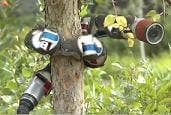Carnegie Mellon’s Incredible Robot Snake Climbs a Real Tree

Share
Carnegie Mellon has taught its robotic snake to climb trees, though one hopes it won't start offering your spouse apples. "Uncle Sam" (presumably named for its red, white, and blue markings) is a snake robot built from modular pieces. The latest in a line of 'modsnakes' from Carnegie Mellon's Biorobotics Lab, Uncle Sam can move in a variety of different ways including rolling, wiggling, and side-winding. It can also wrap itself around a pole and climb vertically, which comes in handy when scaling a tree. You have to watch this thing in action. There is something incredibly life-like, and eerie, about the way it scales the tree outdoors and then looks around with its camera 'eye'. Projects like Uncle Sam show how life-mimicking machines could revolutionize robotics in the near future.
Nature is a fantastic designer. Sure, she works slowly, but every project is subjected to years of testing and refinement. It's no wonder then that we see engineers looking to nature for inspiration in robotics. We've reviewed many examples, including Festo's AirPenguins, UC's roach-like Dash robot, and Chiba's hummingbird. Like these other groups, Carnegie Mellon has gone to great lengths to imbue their snake robots with traits from their natural counterparts. The Biorobotics lab has researched the various ways that snakes can move (their gaits) and taught their robots how to follow in their footsteps (so to speak). You can see their effort in the way the Uncle Sam modsnake climbs a tree - the robot seems alive.
Yet what Uncle Sam has over many other bio-inspired robots is its modular design. Built from repeated segments of sensors and actuators, modular bots let you construct larger machines out of relatively simple building blocks. As we've discussed before, modular robotics also allow the possibility for robot to self assemble in the field, and to be easily repaired if a section is damaged.
Be Part of the Future
Sign up to receive top stories about groundbreaking technologies and visionary thinkers from SingularityHub.


Carnegie Mellon, then, is really pursuing the best of both worlds. Their designs for modsnakes incorporate animal-like movements with very machine-like repetitive construction. That's a model that could work again and again in robotics moving forward.
Despite the emphasis placed on humanoid robots, animal-like bots have clear advantages and are relatively simpler to build. Snake bots could be hunting for survivors in fallen buildings after natural disasters. With modular design these bots could be as long as they needed. If engineers can work out issues with power supply (you'll notice Uncle Same is on a tether) they may be here very soon. In any case, I'm sure we'll be hearing more about Carnegie Mellon's modsnakes in the near future. Especially if Samuel L. Jackson sees this video.
Somebody get these m@#$*#@ f%$%* robot snakes out this m#$%#$* f#$*$% tree!
[screen capture and video credit: Carnegie Mellon]
[source: Carnegie Mellon Biorobotics Lab]
Related Articles

New Gene Drive Stops the Spread of Malaria—Without Killing Any Mosquitoes

These Robots Are the Size of Single Cells and Cost Just a Penny Apiece

New Immune Treatment May Suppress HIV—No Daily Pills Required
What we’re reading
